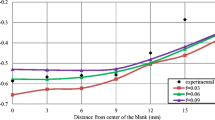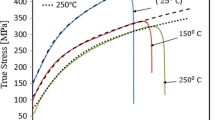Abstract
This study aims to accurately select a yield criterion by utilizing the identification coefficient method to describe anisotropic behavior using material parameters and finite element simulation. The influence of anisotropy is investigated and compared with experimental data. Three yield functions, namely von Mises, Hill’48R, and Hill’48S, are analyzed and their impact on numerical results is investigated using the Kim-Tuan stress–strain model for hardening law. The SPCC material (cold-rolled mild steel) is used for experimental validation. The main variables under study are the fracture height of cylinder cups and the evolution of simulated punch force. The deep drawing process of SPCC cylindrical cups is simulated using the finite element method (FEM) to evaluate the impact of the yield criterion on fracture height. The predicted punch force evolution remains consistent regardless of the yield criterion used, but the fracture height of cylinder cups is significantly influenced by the choice of yield criterion. The von Mises yield criterion leads to a significantly lower fracture height, while the Hill’48S yield criterion yields a fracture height that is too high. However, the results demonstrate that the Hill’48R yield criterion exhibits the most favorable agreement with experimental data for the fracture height of cylinder cups in deep drawing process. Additionally, the study investigates the influence of process parameters such as blanking holder force (FBH), nose radius of the punch (Rp), and limiting drawing ratio (Mt) on fracture height and addresses optimization problems. A highly accurate mathematical model is developed to predict fracture height based on FBH, Rp, and Mt, achieving a deviation of only 4.81% when compared to corresponding experimental values. These findings contribute significantly to the advancement of sheet metal forming technology in various industries, particularly in reducing defective product rates.











Similar content being viewed by others
References
Sigvant M, Pilthammar J, Hol J, Wiebenga JH, Chezan T, Carleer B, van den Boogaard T (2019) Friction in sheet metal forming: Influence of surface roughness and strain rate on sheet metal forming simulation results. Procedia Manuf 29:512–519. https://doi.org/10.1016/j.promfg.2019.02.169
Ikumapayi OM, Akinlabi ET, Madushele N, Fatoba SO (2020) A brief overview of bending operation in sheet metal forming. In: Emamian SS, Awang M, Yusof F (eds) Advances in manufacturing engineering. Lecture Notes in Mechanical Engineering. Springer, Singapore. https://doi.org/10.1007/978-981-15-5753-8_14
Oliveira MC, Fernandes JV (2019) Modelling and simulation of sheet metal forming processes. Metals 9(12):1356. https://doi.org/10.3390/met9121356
Wahyanti S, Anggono AD, Siswanto WA (2020) Study of wrinkling and thinning behavior in the stamping process of top outer hatchback part on the SCGA and SPCC materials. Adv Sci Technol Eng Syst 5(3):241–248. https://doi.org/10.25046/aj050331
Phanitwong W, Thipprakmas S (2020) Multi draw radius die design for increases in limiting drawing ratio. Metals (Basel) 10(7):1–17. https://doi.org/10.3390/met10070870
Tran MT, Shan Z, Lee HW, Kim DK (2021) Earing reduction by varying blank holding force in deep drawing with deep neural network. Metals (Basel) 11(3):1–23. https://doi.org/10.3390/met11030395
Luyen TT, Tong VC, Nguyen DT (2021) A simulation and experimental study on the deep drawing process of SPCC sheet using the graphical method. Alexandria Eng J 61(3):2472–2483. https://doi.org/10.1016/j.aej.2021.07.009
Wang H, Shen X (2021) A novel hydrodynamic deep drawing utilizing a combined floating and static die cavity. Int J Adv Manuf Technol 114(3):829–839
Bamdad AH, Hashemi R (2021) Analytical and numerical investigation of wrinkling limit diagram in deep drawing of two-layer sheets with experimental verification. Proc Inst Mech Eng Part L J Mater Des Appl 235(5):974–990. https://doi.org/10.1177/1464420720985315
Ballikaya H, Savas V, Ozay C (2020) The limit drawing ratio in die angled hydromechanical deep drawing method. Int J Adv Manuf Technol 106(1):791–801
Lee MS (2020) A study on collision characteristic of center-pillar with CR420 and hot stamped steel during side crash simulation. Int J Crashworthiness 1–11. https://doi.org/10.1080/13588265.2020.1826824
Villagomez LE, Cortés D, Ramírez J, Álvarez A, Batres R, Reyes I, Esparza G, Cruz N, Molina A (2019) Discrete Event Simulation as a Support in the Decision Making to Improve Product and Process in the Automotive Industry - A Fuel Pump Component Case Study. Working Conference on Virtual Enterprises 572–581. https://doi.org/10.1007/978-3-030-28464-0_50
Mikušová N, Badiarová S, Jeřábek K (2020) Optimization of Welding Pliers Production for the Automotive Industry – Case Study. Adv Sci Technol Res J 14(4):240–249. https://doi.org/10.12913/22998624/128105
Firu AC, Tapîrdea AI, Feier AI, Drăghici G (2021) Virtual reality in the automotive field in industry 4.0. Mater Today Proc 45:4177–4182. https://doi.org/10.1016/j.matpr.2020.12.037
Lee MS (2022) A study on collision characteristic of center-pillar with CR420 and hot stamped steel during side crash simulation. Int J Crashworthiness 27(2):554–564. https://doi.org/10.1080/13588265.2020.1826824
Mulyanto B, Khaerudini DS (2020) Simulation and Experimental Investigation of Wrinkle Defect in Deep Drawing Process of Carbon Steel Spcc Shaped Cylinder Flange Cup. Sinergi 24(3):197. https://doi.org/10.22441/sinergi.2020.3.004
The-Thanh L, Tien-Long B, The-Van T, Duc-Toan N (2019) A study on a deep-drawing process with two shaping states for a fuel-filter cup using combined simulation and experiment. Adv Mech Eng 11(8):1–11. https://doi.org/10.1177/1687814019872674
Jankree R, Thipprakmas S (2020) Achievements of nearly zero earing defects on spcc cylindrical drawn cup using multi draw radius die. Metals (Basel) 10(9):1–16. https://doi.org/10.3390/met10091204
Yang X, Wang B, Zhou J, Dang L, Xiao W, Wang Y (2020) Influence of processparameters on deep drawing of 2060 Al–Li alloy under hot stamping process. Int J Light Mater Manuf 3(1):36–42
Butuc MC, Gracio JJ, Barata da Rocha A (2003) A theoretical study on forming limit diagrams prediction. J Mater Process Technol 142(3):714–724. https://doi.org/10.1016/S0924-0136(03)00813-6
Hill R (1948) A Theory of the Yielding and Plastic Flow of Anisotropic Metals. Proc R Soc A Math Phys Eng Sci 193(1033):281–297. https://doi.org/10.1098/rspa.1948.0045
Hill R (1952) On discontinuous plastic states, with special reference to localized necking in thin sheets. J Mech Phys Solids 1(1):19–30. https://doi.org/10.1016/0022-5096(52)90003-3
Kuwabara T, Banabic D, Barlat F, Cazacu O (2020) Advances in anisotropy of plastic behaviour and formability of sheet metals. Int J Mater Form. https://doi.org/10.1007/s12289-020-01580-x
Hou Y, Min J, Lin J, Liu Z, Carsley JE, Stoughton TB (2017) Springback prediction of sheet metals using improved material models. Procedia Eng 207:173–178
Barlat F, Lian K (1998) Plastic behavior and stretchability of sheet metals. Part I: A yield function for orthotropic sheets under plane stress conditions. Int J Plast 5(1):51–66. https://doi.org/10.1016/S0749-6419(98)00010-1
Yoon J-W, Barlat F, Dick RE, Chung K, Kang TJ (2004) Plane stress yield function for aluminum alloy sheets—part II: FE formulation and its implementation. Int J Plast 20(3):495–522. https://doi.org/10.1016/S0749-6419(03)00099-8
Deng Z, Hennig R (2017) Influence of material modeling on simulation accuracy of aluminum stampings. pp. 1–9. https://doi.org/10.1088/1742-6596/896/1/012025
Banabic D, Aretz H, Comsa DS, Paraianu L (2005) An improved analytical description of orthotropy in metallic sheets. Int J Plast 21(3):493–512. https://doi.org/10.1016/j.ijplas.2004.04.003
Pham QT, Lee MG, Kim YS (2019) Characterization of the isotropic-distortional hardening model and its application to commercially pure titanium sheets. International Journal of Mechanical Sciences 160:90–102. https://doi.org/10.1016/j.ijmecsci.2019.06.023
Lou Y, Yoon JW (2023) Lode-dependent anisotropic-asymmetric yield function for isotropic and anisotropic hardening of pressure-insensitive materials. Part I: Quadratic function under non-associated flow rule. Int J Plast 103647. https://doi.org/10.1016/j.ijplas.2023.103647
Zhang S, Lou Y, Yoon JW (2023) Earing prediction with a stress invariant-based anisotropic yield function under non-associated flow rule. Int J Mater Form 25. https://doi.org/10.1007/s12289-023-01749-0
Lou Y, Zhang C, Zhang S, Yoon JW (2022) A general yield function with differential and anisotropic hardening for strength modelling under various stress states with non-associated flow rule. Int J Plast 158:103414. https://doi.org/10.1016/j.ijplas.2022.103414
Hou Y, Min JY, Lin JP, Lee MG (2022) Modeling stress anisotropy, strength differential, and anisotropic hardening by coupling quadratic and stress-invariant-based yield functions under non-associated flow rule. Mech Mater 174:104458
Hu Q, Yoon JW (2021) Analytical description of an asymmetric yield function (Yoon2014) by considering anisotropic hardening under non-associated flow rule. Int J Plast 140:102978
Yoon JW, Lou Y, Yoon J, Glazoff MV (2014) Asymmetric yield function based on the stress invariants for pressure sensitive metals. International Journal of Plasticity 56:184–202. https://doi.org/10.1016/j.ijplas.2013.11.008
Hibbitt D, Karlsson B, Sorensen P (2011) ABAQUS standard user’s manual. Version (6.11-3). Dassault Systèmes Simulia Corp. Provid, RI, USA, Providence
Takalkar AS, Chinnapandi LBM (2019) Deep drawing process at the elevated temperature: A critical review and future research directions. CIRP J Manuf Sci Technol 27:56–67
Tiwari PR, Rathore A, Bodkhe MG (2022) Factors affecting the deep drawing process–A review. Mater Today Proc 56:2902–2908
Bouchaâla K, Ghanameh MF, Faqir M, Mada M, Essadiqi E (2021) Numerical investigation of the effect of punch corner radius and die shoulder radius on the flange earrings for AA1050 and AA1100 aluminum alloys in cylindrical deep drawing process. Heliyon 7(4):e06662
Luyen TT, Nguyen DT (2023) Improved uniformity in cylindrical cup wall thickness at elevated temperatures using deep drawing process for SPCC sheet steel. J Braz Soc Mech Sci Eng 45:348. https://doi.org/10.1007/s40430-023-04270-2
Lou Y, Zhang S, Yoon JW (2019) A reduced Yld 2004 function for modeling of anisotropic plastic deformation of metals under triaxial loading. Int J Mech Sci 161:105027
Thuillier S, Manach PY, Menezes LF (2010) Occurrence of strain path changes in a two-stage deep drawing process. J Mater Process Technol 210(2):226–232. https://doi.org/10.1016/j.jmatprotec.2009.09.004
Luyen T-T, Pham Q-T, Kim Y-S, Nguyen D-T (2019) Application/Comparison Study of a Graphical Method of Forming Limit Curve Estimation for DP590 Steel Sheets. J Korean Soc Precis Eng 36(9):883–890. https://doi.org/10.7736/kspe.2019.36.9.883
Swift HW (1952) Plastic instability under plane stress. J Mech Phys Solids 1(1):1–18
Voce E (1948) The relationship between stress and strain for homogeneous deformation. J Inst Met 74:537–540
Pham QT, Kim YS (2017) Identification of the plastic deformation characteristics of AL5052-O sheet based on the non-associated flow rule. Metall Mater Trans A 48(1):254–263. https://doi.org/10.1007/s12540-017-6378-5
Lee Y, Cho J (2021) Development of an Artificial Intelligence Education Model of Classification Techniques for Non-computer Majors. JOIV Int J Inform Vis 5(2):113. https://doi.org/10.30630/joiv.5.2.552
Meranggi DGT, Yudistira N, Sari YA (2022) Batik Classification Using Convolutional Neural Network with Data Improvements. JOIV Int J Inform Vis 6(1):6. https://doi.org/10.30630/joiv.6.1.716
Mac T-B, Dinh V-C, Banh T-L, Nguyen D-T (2018) Cutting Force Model for Thermal-Assisted Machiningof Tool Steel Based on the Taguchi Method. Metals 8(12):992. https://doi.org/10.3390/met8120992
Funding
This work was supported by Hung Yen University of Technology and Education, Vietnam (Grant numbers UTEHY.L.2023.04).
Author information
Authors and Affiliations
Contributions
All authors contributed to the conceptualization and design of the study. Luyen The Thanh and Nguyen Duc Toan were responsible for the material preparation, data collection, and analysis. Mac Thi Bich and Banh Tien Long were involved in the validation and investigation process. The initial draft of the manuscript was prepared by Luyen The Thanh and Nguyen Duc Toan, and all authors provided feedback and contributed to revising earlier versions of the manuscript. All authors have reviewed and approved the final version of the manuscript.
Corresponding author
Ethics declarations
Conflicts of interest
The authors declare no competing interests.
Additional information
Publisher's note
Springer Nature remains neutral with regard to jurisdictional claims in published maps and institutional affiliations.
Rights and permissions
Springer Nature or its licensor (e.g. a society or other partner) holds exclusive rights to this article under a publishing agreement with the author(s) or other rightsholder(s); author self-archiving of the accepted manuscript version of this article is solely governed by the terms of such publishing agreement and applicable law.
About this article
Cite this article
Luyen, TT., Mac, TB., Banh, TL. et al. Investigating the impact of yield criteria and process parameters on fracture height of cylindrical cups in the deep drawing process of SPCC sheet steel. Int J Adv Manuf Technol 128, 2059–2073 (2023). https://doi.org/10.1007/s00170-023-12022-8
Received:
Accepted:
Published:
Issue Date:
DOI: https://doi.org/10.1007/s00170-023-12022-8




